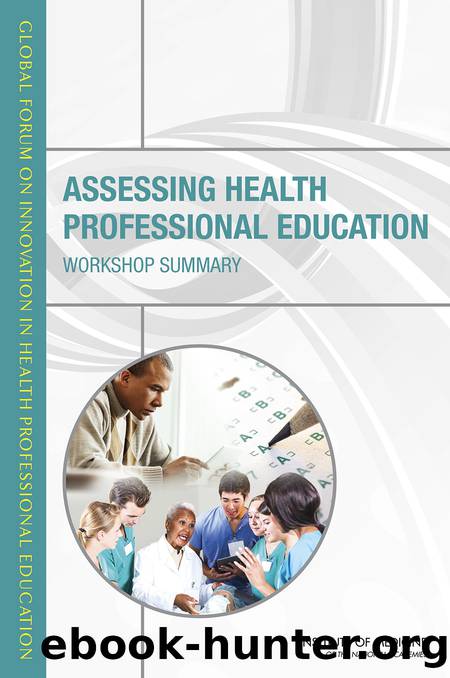Assessing Health Professional Education: Workshop Summary by Patricia A. Cuff

Author:Patricia A. Cuff
Language: eng
Format: epub
Publisher: The National Academies Press
Published: 2014-09-25T00:00:00+00:00
The MOOC would be sponsored and designed jointly, but the impact evaluation could be conducted by each individual profession. The results could then be compared to see whether the learning was as effective with one profession as with another.
Developing the MOOC across health professional associations would in itself add to the collaboration of health professionals. For this to succeed, said Aschenbrener, each institution would have to engage faculty from different professions, which would likely build even stronger collaborations. These collaborations could be used for discussion forums and other collaborative opportunities.
ASSESSMENT OF TEAMS AND COLLABORATIONS IN COMMUNITY-BASED ACTIVITIES AND OUTPATIENT TEAMS
Lemmietta McNeilly opened her presentation by acknowledging the large number of challenges there are to assessing teams and collaborations outside of the inpatient, hospital setting. The difficulty of knowing who to include in the assessment is one example. In outpatient settings, practitioners would almost certainly be included, but for education and training purposes, faculty and students would be part of the assessment, and under all circumstances, the community would be involved. Another challenge is how to actively engage the learner at the policy, institutional, and individual level in collaborative effortsâacross the education-to-work continuumâthat maintains the community as the focal point. Patricia Hinton Walker then addressed the microlevel opportunities (see Table 5-2) within this area of assessment, and offered suggestions for making the best use of those opportunities.
The overall goal of McNeilly and Walkerâs suggested approach to overcoming challenges to assessing community-based IPE (see Box 5-4) is to transform curricula and remove barriers so learners can pursue their passions. In doing, students and faculty facilitate change and provide leadership to address such issues as social justice, civic responsibility, and social accountability in communities. The definition of community could be local or global, but the essence of the curricula would remain the same: to provide opportunities and tools for developing leadership skills and agents for change. To create the envisioned change agents, said Walker, the experience would have to go beyond the brief clinical visits that often make up the experiences of health professional students and provide longitudinal, experiential learning opportunities. However, for this to be successful, systems that embrace continued input and participation of learners would need to be designed, said Walker. Letting students help shape the curriculum may be one way to actively engage them. Another way to engage students is to provide credit for service learning projects. These projects could involve clinical and community experiences as well as those at the policy level where accreditation issues could be addressed. And finally, making the most of emerging technologies could potentially drive the assessment process that ultimately improves health and continuity of care for individuals, families, and communities. Walker suggested this strategy can be successful, provided that educators and others allow such creative learning approaches to enter into health professional education.
TABLE 5-2 Opportunities for Assessing Teams and Collaborations in Community-Based Activities and Outpatient Teams, Outlined by Lemmietta McNeilly and Patricia Hinton Walker (as informed by group discussions)
Download
This site does not store any files on its server. We only index and link to content provided by other sites. Please contact the content providers to delete copyright contents if any and email us, we'll remove relevant links or contents immediately.
| Administration & Medicine Economics | Allied Health Professions |
| Basic Sciences | Dentistry |
| History | Medical Informatics |
| Medicine | Nursing |
| Pharmacology | Psychology |
| Research | Veterinary Medicine |
Periodization Training for Sports by Tudor Bompa(7914)
Why We Sleep: Unlocking the Power of Sleep and Dreams by Matthew Walker(6348)
Paper Towns by Green John(4785)
The Immortal Life of Henrietta Lacks by Rebecca Skloot(4248)
The Sports Rules Book by Human Kinetics(4072)
Dynamic Alignment Through Imagery by Eric Franklin(3914)
ACSM's Complete Guide to Fitness & Health by ACSM(3818)
Kaplan MCAT Organic Chemistry Review: Created for MCAT 2015 (Kaplan Test Prep) by Kaplan(3796)
Introduction to Kinesiology by Shirl J. Hoffman(3621)
Livewired by David Eagleman(3531)
The River of Consciousness by Oliver Sacks(3414)
The Death of the Heart by Elizabeth Bowen(3333)
Alchemy and Alchemists by C. J. S. Thompson(3292)
Descartes' Error by Antonio Damasio(3162)
Bad Pharma by Ben Goldacre(3091)
The Gene: An Intimate History by Siddhartha Mukherjee(2925)
The Emperor of All Maladies: A Biography of Cancer by Siddhartha Mukherjee(2921)
The Fate of Rome: Climate, Disease, and the End of an Empire (The Princeton History of the Ancient World) by Kyle Harper(2863)
Kaplan MCAT Behavioral Sciences Review: Created for MCAT 2015 (Kaplan Test Prep) by Kaplan(2814)
